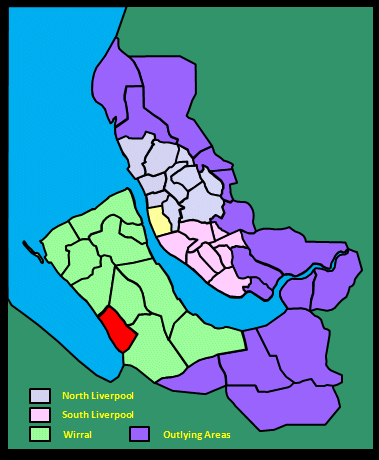 |
Parkgate
The silted up old port of Parkgate on the River Dee was, in the 18th century, a thriving port and a major embarkation point for Ireland. The name comes from a mid-13th century deer park and was adopted around 1600. Lady Hamilton, a local Neston girl and mistress of Lord Nelson, used to bathe here, apparently as a cure for a skin complaint. It is all hard to imagine nowadays, though the sandstone quayside and many original buildings remain. The area attracts many visitors for the atmosphere, bracing air, home made ice cream, pubs and locally caught shrimps. This is the view along the Parade to the south. |
 |
Parkgate in Lewis's Topographical Dictionary of England (1848)
It is situated on the bank of the river Dee, about half a mile westward of the village of Neston; and consists of a long range of houses, which all face the river, and command a magnificent view of the opposite coast of Wales. The quay and parade have been very much improved, at a considerable outlay, by the spirited owner, the Hon. Lloyd Mostyn; and the place is much frequented by visiters during the bathing season. There are several hotels, among which is the Mostyn Arms, a spacious establishment replete with every accommodation. Over the estuary of the Dee is a ferry to Bagilt and Flint. Formerly Parkgate was a sea-port of some note, and packets and other vessels were employed, especially in the trade with Ireland; but at present it is neglected as a port, vessels of burthen being prevented from approaching the quay by a large sand-bank, which impedes the navigation of the river. There was a custom-house, but the business has been transferred to Chester. An act was passed in 1847 for a railway to Bebington on the Birkenhead and Chester line, five miles in length, which will render this place, from the greater facility of reaching it, a still more fashionable and favourite resort. |
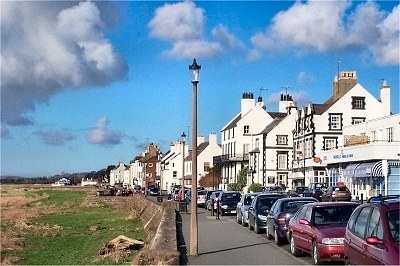 |
Parkgate
The view along the Parade to the north. |
 |
 |
The Red Lion, Parkgate
The Red Lion is at least 300 years old. Its situation is superb and you can sit in the characterful and cosy interior gazing out over the marshes. |
 |
 |
St. Thomas's Church, Parkgate
St. Thomasīs is a Grade II listed sandstone church dating from 1843. Known locally as the Fisherman's Church, it is situated in timeless Mostyn Square. |
 |
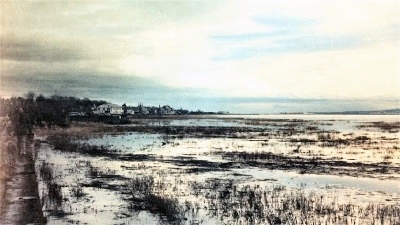 |
High tide at Parkgate
Parkgate only sees the tentative return of water at exceptionally high spring tides or in freak weather conditions. The area is then a paradise for birdwatchers. |
|
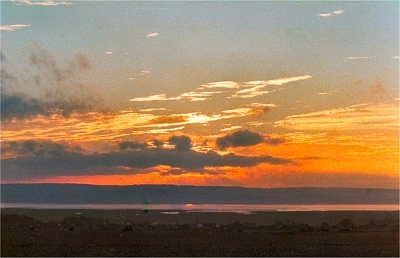 |
Sunset over the Dee Estuary near Parkgate |
|
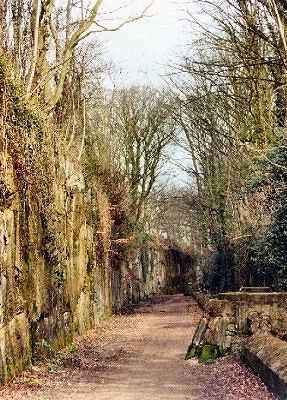 |
The Wirral Country Park near Neston
The Wirral Country Park follows the route of the old Great Western and London North Western railway that used to run from Hooton to West Kirby, the other stations being Hadlow Road (Willaston), Neston South, Parkgate, Heswall, Thurstaston, Caldy and Kirby Park. The line was closed to passengers in 1956. In 1970, the route was taken to form the basis of the Wirral Country Park, Britain's first country park. In one of its more interesting sections near Neston, the track here cuts deeply through the sandstone bedrock. |
 |
 |
Neston Old Quay
The Old Quay at Neston was an embarkation point for Ireland earlier than Parkgate, but, being further upstream, it silted up first and had become unusable by the early 18th century. |
 |
Neston in Lewis's Topographical Dictionary of England (1848)
The town is pleasantly situated on an eminence about a mile from the Dee, and is much frequented during the summer months for the benefit of bathing at Parkgate, a hamlet partly in Great Neston township, and which is separately described. The air is very salubrious, and the views beautiful and extensive. [...] The flatness of the country, and the prevalence of sea breezes, which prevent the growth of timber, have given the surface a rather naked appearance, and may in some measure account for the parish having been for centuries deserted by nearly all its principal landowners. Several coal-mines have long been in operation; and coal of most excellent quality has been very recently discovered on the lands of the Hon. E. M. Lloyd Mostyn, which, it is supposed, is a continuation of the Flint and Bagilt coal-field: if this should prove to be the case, Birkenhead may derive from this new source the supplies of coal required for its use, and for exportation, on far easier terms than from any other quarter. [...] The church is a handsome and spacious edifice of considerable antiquity, having a nave, chancel, and aisles formerly terminating in small chapels, and also a tower, supposed to have been rebuilt in 1697; the edifice was restored in 1792: the font is an extremely elegant piece of workmanship, and was erected rather more than 400 years since. |
Neston and Parkgate in The Beauties of England and Wales, Vol II, Edward Wedlake Brayley and John Britton (1809)
Great Neston is a populous market town on the western side of the peninsula, commanding some pleasant views of the Dee and the opposite coasts of Wales. The church is a handsome and spacious structure, and many of the houses are good modern buildings. The inhahitants derive considerable advantage from the contiguity of Parkgate, which of late years has become a convenient and fashionable bathing-place. It is also celebrated as the station for some of the packets for Ireland, which generally sail to that country four times a week. The houses of Parkgate are chiefly disposed in one long range on the Dee banks, and are mostly neat modern buildings of brick. The inhahitants, who are pretty numerous, derive their principal support from the expenditure of the many visitants that reside here in the bathing season. |
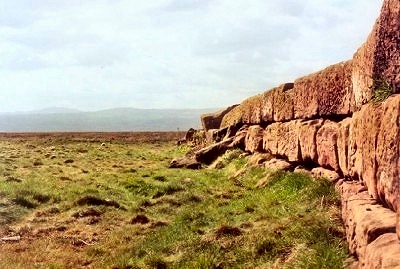 |
Denhall Quay, Little Neston
Denhall Quay served the Denhall Colliery operations that probably started here in the 17th century under particularly miserable conditions for the miners, some of whom nevertheless made the crossing of the Dee from Wales to work here. It dates from the 1760s and coal was shipped from here to ports in North Wales, Ireland and the Isle of Man. The nearby Wirral Colliery, of which the spoil heaps are still visible (though cosmetically concealed), was opened in 1759. Underground canals were built beneath the Dee Estuary and man-powered boats were used to bring the coal from distant faces to the pit shaft, but all colliery operations finally ceased in 1928. Slate and limestone were imported and other industries here included coke and charcoal making, brick and tile making and metal smelting. This now peaceful area was once the largest industrial site in the Wirral. |
 |
 |
The Harp Inn, Little Neston
The unspoilt 17th century miners' pub, the Harp, is superbly situated on the edge of the marshes at Little Neston. Inside are old photographs of the area. |
 |
 |
The Dee Marshes at Little Neston
A view of the Clwydian Hills over the River Dee marshes at Denhall Quay, Little Neston. |
 |
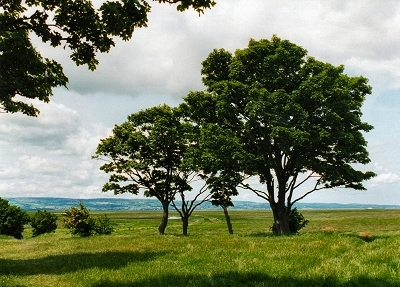 |
The Dee Marshes at Little Neston
There is little open water here nowadays, but the area has a unique atmosphere in all weather conditions. Walking along the edge of the marshes, with only the sound of birdsong and the wind, is a rewarding (and sometimes bracing) experience. |
 |
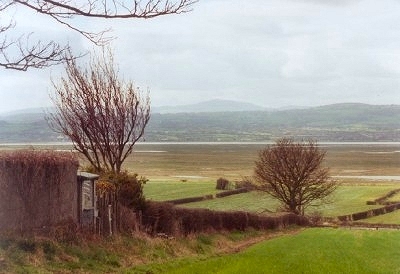 |
The Dee Estuary at Ness
An elevated view towards Wales over the Dee estuary at Ness showing Moel Fammau, the highest hill in the Clwydian range, on the horizon. |
 |
Ness in Lewis's Topographical Dictionary of England (1848)
Here are very extensive collieries, situated on the margin of the Dee, under which the veins of coal run for a considerable distance towards the opposite coast of Flintshire: they have yielded an immense supply since they were first opened. The greater part of the township, which altogether comprises 852 acres of a sandy clay soil, is of very inferior quality, and much of it absolutely worthless. The village consists of hovels inhabited by the colliers. Denhall House stands on the bank of the river, and, with the grounds attached to it, forms a pleasing exception to the bleak and dreary prospect; it is the seat of Charles Stanley, Esq. (uncle of Sir William Stanley), who, and Mr. Errington, the Earl of Shrewsbury, and others, are proprietors of the collieries and the township. |
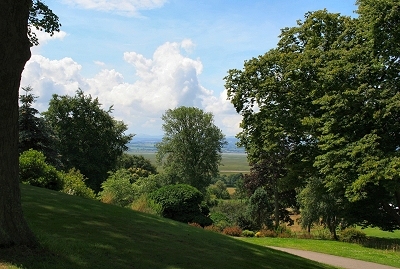 |
Ness Botanic Gardens
Ness Botanic Gardens was born of Liverpool cotton merchant Arthur Kilpin Bulley's passionate interest in plants and his desire to share that interest with others. Bulley was interested in introducing new plant species from abroad. In particular, he believed that Himalayan and Chinese mountain plants could be established in Britain. In order to test this theory, he sponsored expeditions to the Far East. In this way Bulley was responsible for introducing hundreds of new plants to Britain. Bulley died in 1942, and in 1948 his daughter Lois presented the Gardens to the University of Liverpool with an endowment of £75,000. The only stipulation was that they be kept as a botanic gardens as a practical and fitting tribute to the memory of her father. The area of the gardens was subsequently increased to 46 acres (18.4 ha). A new £2 million visitor centre opened in 2006, featuring a central courtyard area with reception, indoor café, outside garden area, shop, lecture theatre, conservatory and exhibition room. |
|
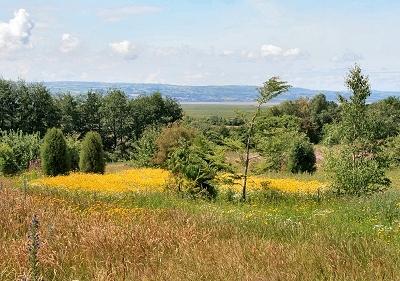 |
Ness Botanic Gardens
A wild flower meadow. Here on its western edge, Wirral lies in the path of moist, south-westerly winds, but it is also in the lee of the North Wales mountains. This reduces the amount of annual rainfall it receives to about 30 in (75 cm). Although wetter than the east coast of England, it is still one of the driest districts on the west coast. The area also experiences relatively few and less severe frosts because of its proximity to the coast. The gardens are situated on and around a sandstone promontory with variable soils. The higher areas of the Gardens on the sandstone ridges have thin, acid, well-drained sandy soils, whereas the lower areas are on lime-rich clays. |
|
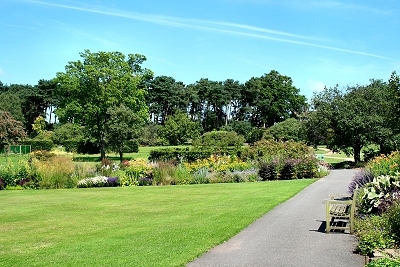 |
Ness Botanic Gardens
Spring and early summer are the time for rhododendrons, azaleas, camellias, magnolias, cherries, the laburnum arch and many other flowering trees and shrubs, along with spring bulbs and primulas. In summertime there are lilies, primulas, herbaceous borders, terrace gardens with many climbing plants, and native plant, herb and water gardens. Late summer and autumn are the time for trees for fruits and autumn colour, the heather garden, sorbus, maples, the water garden and autumn bulbs. Winter is a good time for a wide selection of trees and shrubs with coloured fruits, bark and stems, and also conifers. |
|
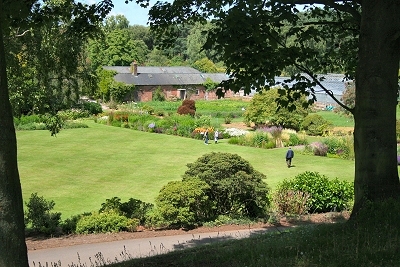 |
Ness Botanic Gardens
The central lawn. |
|
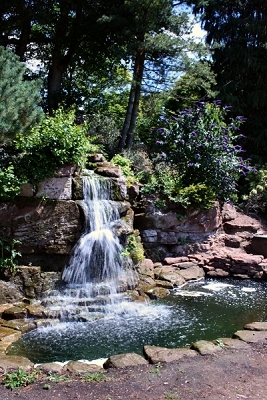 |
Ness Botanic Gardens
Waterfall in the Rock Garden. |
|
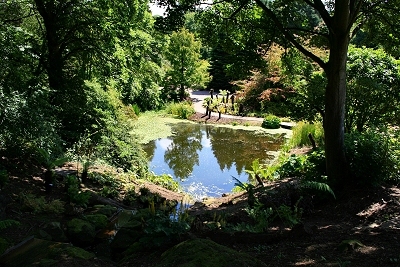 |
Ness Botanic Gardens
The pond in the Rock Garden. |
|
